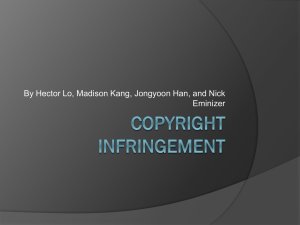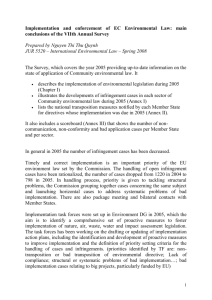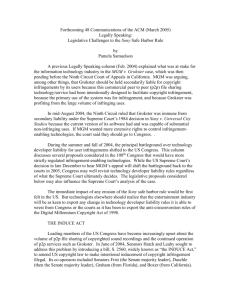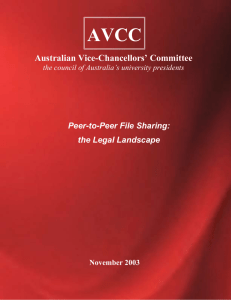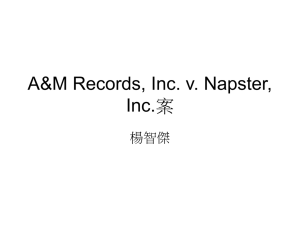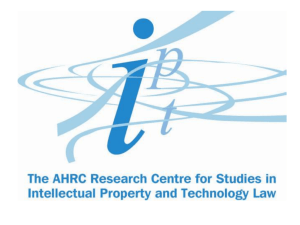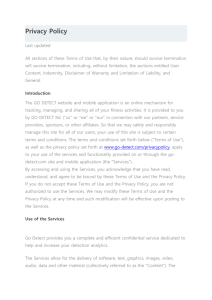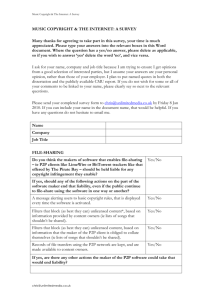Analysis & Solution for Indirect Infringing Liability of Developers of
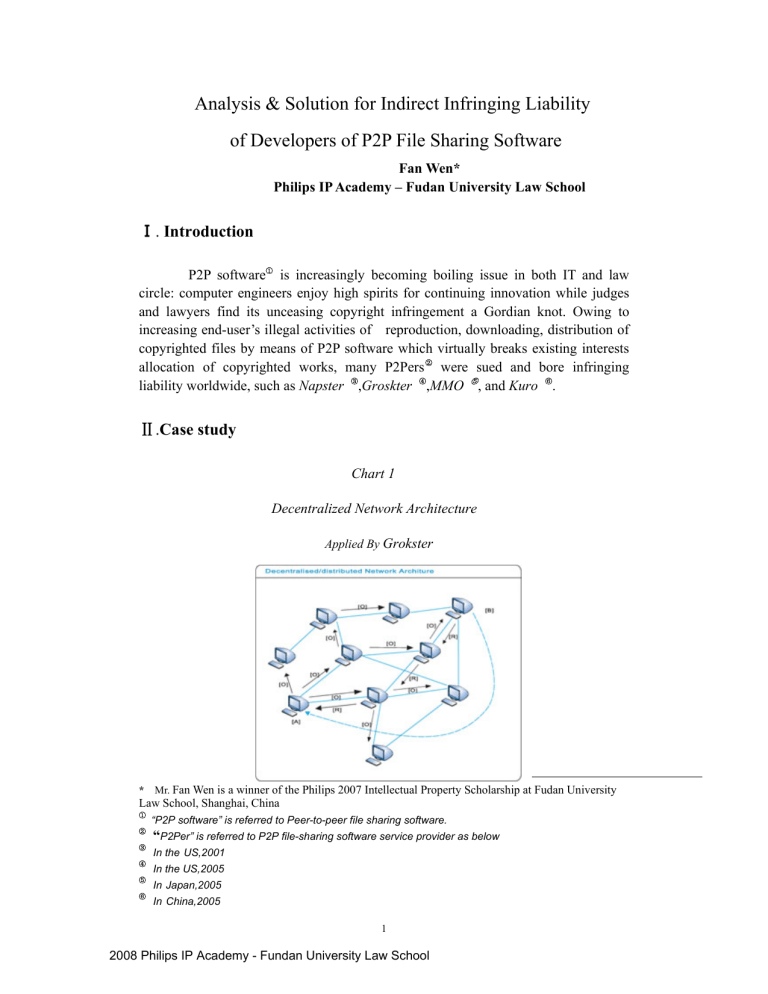
Analysis & Solution for Indirect Infringing Liability of Developers of P2P File Sharing Software
Fan Wen*
Philips IP Academy – Fudan University Law School
Ⅰ
.
Introduction
P2P software
①
is increasingly becoming boiling issue in both IT and law circle: computer engineers enjoy high spirits for continuing innovation while judges and lawyers find its unceasing copyright infringement a Gordian knot. Owing to increasing end-user’s illegal activities of reproduction, downloading, distribution of copyrighted files by means of P2P software which virtually breaks existing interests allocation of copyrighted works, many P2Pers
②
were sued and bore infringing liability worldwide, such as Napster
③
, Groskter
④
, MMO
⑤
, and Kuro
⑥
.
Ⅱ
.
Case study
Chart 1
Decentralized Network Architecture
Applied By Grokster
* Mr.
Fan Wen is a winner of the Philips 2007 Intellectual Property Scholarship at Fudan University
Law School, Shanghai, China
①
“P2P software” is referred to Peer-to-peer file sharing software.
②
“
P2Per” is referred to P2P file-sharing software service provider as below
③
④
In the US,2001
In the US,2005
⑤
In Japan,2005
⑥
In China,2005
1
2008 Philips IP Academy - Fundan University Law School
①
Chart 1 shows Grokster ’s decentralized network architecture. Under
American traditional liability theory, Grokster-like companies did not constitute either contributory infringement or vicarious liability due to their inability of controlling and monitoring end-user’s activities of unauthorized files’ sharing. They have been exempted from being liable pursuant to their end-users’ direct infringement until the
Supreme Court issued its ruling in MGM v. Grokster in which it announced a new form of indirect liability described as below:
“[O]ne who distributes a device with the object of promoting its use to infringe copyright, as shown by clear expression or other affirmative steps taken to foster infringement, is liable for the resulting acts of infringement by third parties.”[1]
The essential of the Supreme Court’s ruling has two points: One is Grokster proclaimed itself as “Next Napster” and promised to provide the same function as
Napster ’s with end-users in its advertisements in order to capture market-share left by belly-up Napster . Therefore Grokster constituted a “intent” to promote end-users to conduct direct infringement. Another point is Grokster had negatively evade to filter end-users’ infringing materials. Therefore Grokster ’s said acts materially formed a
“intent” promoting exchange for unauthorized files among end-users thus the
Supreme Court held Grokster to form an inducement.
Second, inducement requires copyrighter to prove the P2Pers had subjective malice in their software’s commercial operation, otherwise P2Pers can invoke the
“ Batamax defense ” derived from the Supreme Court’s finding in Sony v. Universal
City Studios for noninfringrment. However, it is not an easy job for copyrighter to fulfill this burden of proof.
The EFF advices presented by Mr.Lohmann are constructive and mostly practical for Grokster-like companies even who are non-American including Chinese
P2Pers. Yet I have three different opinions from Mr.Lohmann’s advices.
1.“ Total control or no control ”. As Mr.Lohmann said, P2Pers have two choices to thoroughly exempted from indirect infringement: “Either build a system that allows for thorough monitoring and control over end-user activities, or build one that makes such monitoring and control impossible”. However, even through P2P software’s architecture makes P2Pers monitor and control the operation of software impossible, they still may be held liable for inducement if there were enough evidence in their software’ promotion proving they have intent to promote ,encourage or foster end-users to act direct infringement.
①
Cited from www.ppcn.com
2
2. “ Disaggregate functions ”. In Mr.Lohmann’s view, separating P2P software’s functional composition brings about legal advantages. In the part Ⅳ of paper “What
Peer-to-peer Developers Need to Know about Copyright Law ”, he wrote it down :
“Part of Napster’s downfall was its combination of indexing, searching, and file sharing in a single piece of software. If each activity is handled by a different product and vendor, on the other hand, each entity may have a better legal defense to a charge of infringement.” “A disaggregate model, moreover, may limit what a court can order you to do to stop infringing activities by your users.” “In addition, certain functions may be entitled to special protections under the ‘safe harbor’ provision of
DMCA…….. Thus, the combination of a P2P file sharing application with a third party search engine might be easier to defend in court than Napster’s integrated solution.”[2] Well, function disaggregation may lower risks of indirect infringement to some extent, but maybe it is not the point. Napster lose the case indeed partly because of its central network architecture, however, the crucial reason is that Napster did not fulfill its monitoring and controlling obligation intentionally and it benefited from end-user’s infringing activities. Furthermore, even if P2Per outsourced some functional modules
① to the third party to execute independently, once copyrighter who found his works were infringed by end-users while P2Per fails to prove he has implemented obligation of attention, P2Per could still be charged with indirect infringement.
3.
“ Be open source ”. Legally speaking, this idea is good from accused P2Per point of view , but it is may not practical and will induce more disputes. Source code of P2P file-sharing software is P2Per’s the most valuable intellectual properties, if published, who protects P2P’s interests? Moreover, source code can be used by expert end-user to reprogrammed new P2P software which will illegally expel P2Per’s lawful market-share then it may turn out be a total infringing tool without any parties’ monitoring and controlling and cause severer damages to copyrighters. So we need a more sound alternative as P2Per’s solution.
Ⅲ .
Status quo of P2Pers and relating copyright law in China
Chinese P2Pers are also facing more and more austere legal circumstances.
For an example, the Kuro software was held by Chinese court to be liable for copyright infringement.
China has not made special law about P2Pers’ and end-users’ liabilities while relating rules were stipulated in General Principles of Civil Law , Copyright
Law , Judicial Interpretation on Several Legal Issues Relating to Network Copyright
Litigation , and Regulations on Protection for Right to Network Information
Communication . Furthermore, China has not stipulated “ Indirect Infringement ”, let alone prescribed “ Contributory Infringement ”, “ Vicarious Liability ” and
“ Inducement ”.
①
Such as research engine
3
Instead, there are some legal requirements regulating Chinese P2Pers’ activities:
(1).The prescription concerning “ Abetment ” in Article 4 of Judicial
Interpretation on Several Legal Issues Relating to Network Copyright
Litigation ,which is similar to the finding of “ Inducement ” in the Grokster case [3] , prescribed that : “ The people’s court shall investigate and fix the ISP ,who has participated in copyright infringement with somebody through the network or abetted, aided somebody to conduct copyright infringement through network, liabilities for infringement in accordance with the provision of the Article 130 of General Principles of Civil Law”
① , and the stipulation in Article 5,saying that “ The ISP, who provides material service with end-users through network and fully knows that certain end-user has conducted infringing activities towards someone’s copyright, or after copyrighter presenting warning with educated evidence , has failed to take active steps such as removing infringing materials to eliminate the aftereffect causing by end-user’s infringement
, shall be investigated and fixed liabilities for joint infringing liabilities with the certain end-user by the people’s court in accordance with the provision of the Article 130 of General Principles of Civil Law”
②
, it means P2Pers still need to bear active monitoring and controlling obligations lest end-user infringe copyright in the P2P software operation whatever kind of architectures the P2P software applies.
(2).
The act of “ Indirect Infringement ” is practically judged to be “ Joint infringement ” in China .
(3).
“ Two or more persons, who have caused damages to somebody by joint tort, shall bear joint infringing liability ” [3], in judicial practice, the Supreme People’s
Court has issued an interpretation for more definite understanding: “ One who abets and aids somebody to conduct infringing activities, is joint infringer ” [4].
Moreover, Regulations on Protection for Right to Network Information
Communication holds conservative attitude towards P2P file-sharing technology in which the regulations about P2Pers in earlier draft have been deleted, and describes
③ that doctrine of liability fixation for network information disseminator is presumptive fault that means the disseminator has to prove he conducts disseminative activities without any faults. So Chinese Grokster-like companies stand in more unfavorable position than Grokster did in American if they were sued against being indirect infringers by copyrighters.
Ⅳ
.
Solution & Improvement
①
“ 网络服务提供者通过网络参与他人侵犯著作权行为,或者通过网络教唆、帮助他人实施侵犯著作权行为
的,人民法院应当根据民法第一百三十条的规定,追究其与其他行为人或者直接实施侵权行为人的共同侵
权责任
”
。
②
“ 通过网络提供内容服务的网络服务者,明知其用户实施了侵犯他人知识产权的行为,或者在著作权人
发出有确切证据的警告后,仍不采取移除侵权内容等措施消除侵权后果的,人民法院应当根据民法通知第
一百三十条的规定,追究其与网络用户的共同侵权责任”。
③
Be similar to contributory infringer in American copyright law sense
4
Through above legal analysis, this essay tries to find a preliminary solution harmonizing IP protection and P2P technology development:
(a) Legal Angle of View
1.
The law shall apply liability for wrongs towards P2Pers’ indirect infringing activities than presumptive fault to balance burdens of proof between P2Pers and copyrighters.
2.
The Chinese courts shall scrupulously abide by “Technology Neutrality” Principle in judging P2Per cases like courts does in American.
3.
P2Pers shall create special legal departments to cope network copyright issues ,and pay royalty for authorization.
(b) Technology Angle of View
1.
Apply “Digital Rights Management”.
2.
To create a fixed, antialien end-user group where file-sharing is authorized by copyrighters and strictly monitored by P2Pers.
3.
To develop IPv6 network demanding end-users using real identities, so P2Pers will not be scapegoat for end-users’ infringing activities.
(c)
Business Angle of View
To create an innovative business model, by which P2Pers collaborate with copyrighters for sharing files warranty like Snocap does in American ,is an ultimate solution for both P2Pers and copyrighters as well.
Citations:
[1].
What Peer-to-Peer Developers Need to Know about Copyright Law
www.eff.org/IP/P2P/p2p_copyright_wp.php
[2].
Ibid
[3].
第 148 条,最高人民法院关于贯彻执行 《中华人民共和国民法通则》 若干问题的意见
(试行)
[4]. 参见 《关于审理涉及计算机网络著作权纠纷案件适用法律若干问题的解释》
5

